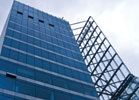

Although large businesses have better buying power than consumers and can forward purchase their energy at locked-in option rates, eventually the rate rises will hit these companies as well. The future for those looking to protect their business’ bottom line looks like an uphill struggle, but retro-fitting a wireless building energy management system (WEMS) is the ideal solution, says Ivan McKeever, director at WEMSinternational.
The implications
Rising energy costs are adding increasing pressure on businesses and the proposed introduction of carbon taxes means that managing emissions will become even more important in coming years. While most companies have stripped significant costs from their business during the economic downturn, there is still a need to cut overheads. That is why it is more important for businesses to consider their energy use and how to manage it in a cost-effective way.
“It is not unusual for a large business to have an energy bill of more than R10 million per year,” says McKeever. “Add into the equation that at least 80% of all buildings in South Africa currently have no energy management systems and it becomes clear that when most businesses are aiming to control their bottom line, the majority are missing out on significant savings by failing to utilise the energy management technology that is available. Such technology can save businesses up to 30% in energy bills.”
So what are the options?
Retro-fitting a wireless energy management system is a cost-effective solution to reduce a business’ consumption. The technology is designed to manage energy use, including the lighting, air conditioning and heating across large property estates. It causes little disruption to the fabric of the building and is implemented quickly – typically in three to four days, compared to several weeks for the more traditional systems. “Wireless technology can reduce carbon emissions and minimise energy costs, while also being significantly cheaper than conventional wired systems. Installation costs are 40 to 50% cheaper and the systems provide a typical payback in 12 months,” explains McKeever. “The technology can also lead to improved public perception of a business as it is seen as an organisation that is proactively seeking to use less energy and reduce its emissions. Wireless technology goes beyond recording energy use by simply metering and monitoring – it is able to change the way an organisation uses energy.”
WEMS at work
As well as the reputational benefits of being seen as an environmentally-conscious company, businesses that utilise WEMS technology also see a significant improvement in the lifespan of equipment as heating, ventilation, lighting and air conditioning units only operate when necessary. Peter Kelly, deputy finance director at Dunelm Mill: “Since we launched the programme of installations in 2010, we have introduced the WEMS systems into our stores and now we are retrofitting the remainder of the estate.
“At Dunelm Mill, we are committed to reducing our energy use in-line with the Carbon Reduction Commitment. This also allows us to fulfil our company philosophy of ‘simply value for money’ by passing on the energy savings to our customers thus offering exceptional value. We are delighted with the results that have been achieved so far, saving as much as 26% of energy costs in some stores across the first 30 stores where the systems were installed.”
What next?
Traditional energy sources are running low and alternatives, such as renewable energy, are not progressing fast enough to make up for this shortfall. With further announcements expected from energy suppliers, and reforms being made to the energy market by the government, it is clear this problem is not going away.
The WEMS system is a completely wireless, web enabled building energy management system (BEMS) that allows users to check, manage or control buildings and energy usage from anywhere in the world. The system can generate SMSs or e-mails for alarm monitoring if predetermined parameters are exceeded, or the site can be optimised via the WEMS Energy Centre.
The system has a line of sight range up to 2 km (this could be less in the built environment). Controllers can double up as repeaters, to achieve a maximum range of up to 6 km line of sight. The system operates on the licence-free band 433 MHz using narrow band wireless technology that supports a variety of controllers and sensors available with I/O options to suit any environment.
For more information contact Full Cycle Facilities Management, +27 (0)11 432 6779, [email protected], www.wems.co.uk

© Technews Publishing (Pty) Ltd | All Rights Reserved